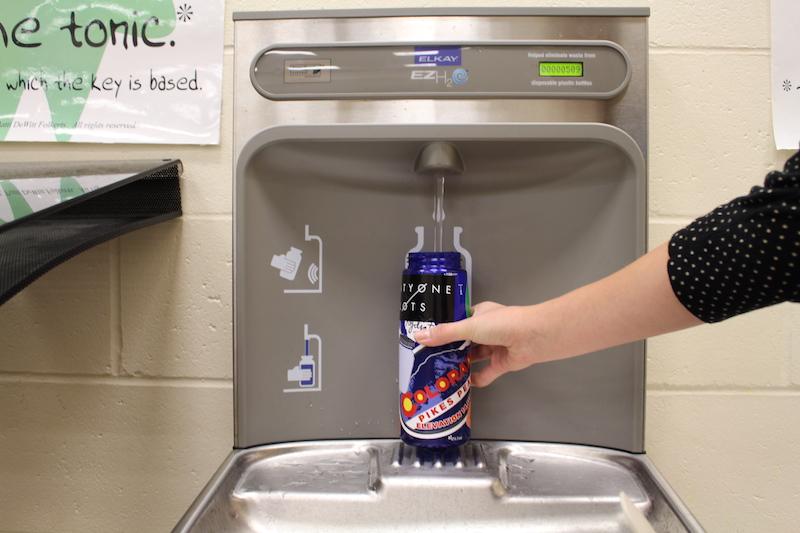Water Bottle Fillers
Halfway through a dramatically long practice, a dry feeling scrapes through the bottom of a choir students throat, slithering up to dry the back of their tongue. As they hold out the last long note, the agonizing pain worsens. This is the recurring nightmare known to every vocal art student.
“Without water, your vocal chords don’t do too well,” vocal art student, Evelyn Hodson, describes her need for water while singing. While choir is a strain on the voice, the art can also include the acts of dancing, adding the need for hydration.
Presently, Battle High school only has one faucet specifically made to fill water bottles. The faucet is located in the “A” hallway, in the choir room. Since choir bought the faucet, the addition has been made a necessity to every student who takes the class and brings a water bottle for their benefit.
The faucet used in the choir room is an attachment from the brand Elkay. According to Elkay’s online website, the faucet is made to remove lead from water. The outcome of filtrated water is cleaner water that doesn’t taste like copper pipes. This is beneficial because most students who fill water bottles daily complain of the copper taste that taints the water.
Kiersten Hardy, a Battle High School student council member, tells what she’s heard from the majority of water bottle users, “Instead of just using water from the original water fountain, which people have complained that the taste is not great, the bottle fillers will have filtered water, so you could fill your bottle there.”
Despite the taste factor these faucets give, they also eliminate waste of single use plastic bottles. Jill Villasana, Student Council sponsor, describes why she enjoys the faucets ability help keep the world clean: “From the environmental lens, I am disgusted by the quantity of single use bottles that are used here at Battle High School.”
While every hallway has a recycling bin specific for plastic bottles and aluminum cans, they’re often overlooked for trashcans. Both cans, however, are placed throughout the school in areas of high traffic. Villasana discusses her observation, “I’ve seen them being thrown away constantly to the point where I’ve gotten the custodians to get me a bottle recycling bin in my room.”
Each Elkay bottle faucet comes with a small built in screen, displaying the amount of single use bottles saved by replacing these plastic bottles with reusable ones. Conserving the number of plastic bottles we use is important because every bottle thrown away contributes to the growing landfills. According to thewaterproject.org, “U.S. landfills are overflowing with 2 million tons of discarded water bottles alone.” By using a reusable water bottle, you don’t have to worry about finding a recycling bin, let alone if the plastic bottle is going to sit in a landfill to take years to biodegrade.
The bottle fillers have been widely desired by the student body, student council ran a poll to find out how many students actually wanted the attachments. The official Student Council twitter ran a poll, with 118 votes, 86% of students voting “yes” for the faucets. However, the work for these faucets rely on electrical ability and funding.
Funding for the water bottle fillers from student council would have to depend on money left for spending. “Student council has raised money from the past couple years from active participation in our homecoming dances, our courtwarming dances, active Battle student participation and faculty participation in our dine out nights on a monthly bases,” Villasana went on to talk about how it was important to student council to give back to the student body in forms that would benefit everybody. Therefore funding would be an important part to getting these filtered faucet attachments into the halls of Battle High School.
Amongst the more important details of the attachments, each water bottle filler is dependent on if there is already a water fountain, and if there is the electrical ability to power the attachment. Villasana describes the dilemmas of the water fountains placement: “The building wasn’t originally fitted out electrically for those water bottle fillers to be at all the water bottle fillers, so that’s just one consideration about the placement.” However, it was agreed by Hodson, Villasana, and Hardy that water bottle fillers should be placed in areas of traffic such as the commons.
Though there are two setbacks, the filtered faucets are much more helpful than providing clean water, without the cost of vending machine beverages. Although every student enjoys the giddy feeling of buying a drink from the vending machine, it is often expensive to sport every day. Hardy contributes to the discussion on vending machines being expensive, “it would be beneficial to use these bottle fillers instead of spending a dollar a day, when you could use a water bottle every day.” A dollar and fifty cents can become a costly investment when you’re spending that amount every day of the school week.
Villasana gives another reason she favors the bottle fillers saying, “I want my students to drink more water, I see a lot of my students drinking sugary vending machine drinks, which drives me crazy because I know it’s healthier for us all to drink more water.” Eatright.org says, the average high school girl needs eight glasses of water daily, while the average high school boy would need eleven glasses of water daily. However, with water faucets making water bottles extremely hard to fill and five minutes of passing time to get the job done, the ability to get the adequate amount of water daily becomes a challenge.
Water bottle fillers create a fast, clean, environmentally healthy way to get water into a water bottle successfully. The fillers would take some time to place into schools, but the possibilities to help get students the right amount of water, cost efficiently, would increase indefinitely.

